“], “filter”: { “nextExceptions”: “img, blockquote, div”, “nextContainsExceptions”: “img, blockquote, a.btn, a.o-button”} }”>
When my mum died in early 2010, my yoga practice changed overnight from one that was predominantly focused on opening my heart to one that allowed my heart to be closed.
She had been ill for three years, and even when I felt overwhelmed and exhausted from the daily realities of her long-term illness, I still tried to push my way through my practice. I had been working on the second series in Ashtanga Yoga, which includes a lot of backbends. I would leave her bedside every afternoon and crank my way through chest-opener after chest-opener, hoping that if I could just “open my heart,” maybe it wouldn’t feel so heavy anymore. After all, that’s what most vinyasa teachers and popular yoga media seemed to promise.
When my mum passed, the weight of recent years and her loss left me crumpled so tightly, I couldn’t even sit upright. When I tried to do the mildest of backbends—even lying on a blanket in the morning for pranayama, it felt painful and just wrong. Forget practicing low Cobra during a vinyasa. Internal alarm bells would go off, my heart rate would skyrocket, and my breath would become constricted. It was as if my nervous system was yelling, “No, we’re not ready for this! Close back up!”
I didn’t make a conscious decision to start practicing differently. Quite simply, my body wouldn’t make certain shapes anymore. I found myself in a new position, especially when I attended vinyasa flow classes. I was one of the student who didn’t jive with what the teacher wanted to teach. It felt like there was an elephant on my chest when it came time to practice backbends. In Urdhva Dhanurasana (Upward-Facing Bow Pose), a pose I usually could have done in my sleep, I was frozen before I could even lift my hips. Even less-intense backbends, such as the usual Urdhva Mukha Svanasana (Upward-Facing Dog Pose), were a challenge. Whereas it once make me feel like my lungs were expanded, I now began to feel like I was drowning.
I also observed how many yoga teachers excitedly taught backbends, announcing as they plugged in their playlist, “We’re heart-opening today!” Their enthusiasm and insistence on the necessity of the practice seemed to create an unspoken assumption that if you were rounded forward, your heart must be closed, and “shame on you.”
I naively believed this, too. I even taught that way for some years as a young teacher in my early 20s. But after losing my mum and then facing a number of subsequent losses and traumas and upheavals, both personal and societal, my body continually helped me realize an important truth: during some periods of life, not only is it okay to keep our hearts closed, it can be necessary.
My theory is that when your heart is broken, you sometimes need to hold yourself close so it can mend.
Practically speaking, in a home practice, it’s relatively easy to tailor your sequence to your needs, but what happens when you attend an in-person heart-opening class when you would much rather keep your heart closed? The answer is the same: modify your practice.
When I began to practice a different pose than the rest of the class, I experience some embarrassment. The whole class would seem to move in one direction, but I would go in another. My embarrassment was almost entirely about how I assumed other students were perceiving me. I can honestly say now that I could care less about doing alternative shapes in public classes. As a teacher, I truly celebrate those kinds of choices in students.
Still, it’s nice to be able to take care of yourself and rely on options that are similar enough to the pose being taught so that you can maintain your place in a vinyasa class and not feel weird. While you may not be doing “heart openers” per se, you are drawing your energy inward to your heart on its deepest level.
7 heart-protecting variations for “heart-opening” poses
1. Instead of Urdhva Mukha Svanasana (Upward-Facing Dog) during Sun Salutation A
Heart-protecting variation: Plank Pose to Balasana (Child’s Pose) before returning to Adho Mukha Svanasana (Downward-Facing Dog)
Why: Have you ever counted how many vinyasas (as in Chaturanga–Urdhva Mukha Svanasana-Adho Mukha Svanasana) you do in a single flow class? A lot. Even if you opt for a milder backbend, such as Bhujangasana (Cobra Pose), repeatedly asking yourself to peel open during a time when your body wants nothing more than to curl in can feel as though you are swimming against the tide, over and over. Instead, try this combination within your vinyasa so you can stay within the flow while honoring your body’s needs.
How to: After you come to Plank Pose, lower your knees. On an exhale, shift your hips back to Balasana (Child’s Pose) for a single breath (this will correspond with the rest of the classes Chaturanga or lowering from Plank to the floor) as you inhale and curl your toes under, lift your knees off the floor (this will correlate with the rest of the classes backbend), and exhale directly back into to Downward Facing Dog.
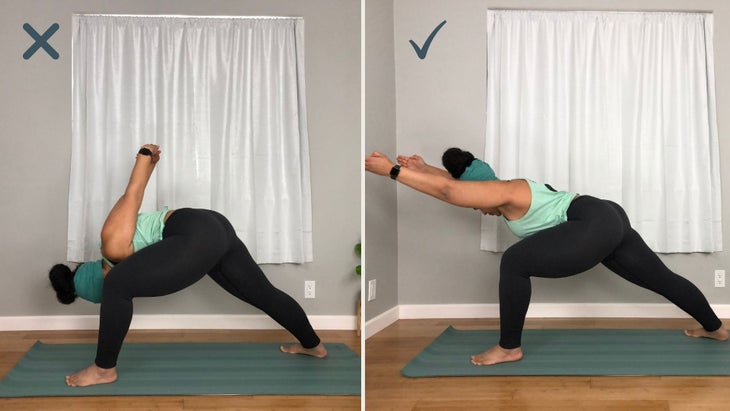
2. Instead of Humble Warrior
Heart-protecting variation: Virabhadrasana 1 (Warrior 1) while keeping your torso low and reaching your arms forward
Why: Humble Warrior may seem innocent enough, but it not only asks us to open our chest, it also asks us to keep our chest open against the weight of gravity. During heavier periods of life, gravity can actually be like a comforting blanket, rather than a giant barbell you are trying to lift against. Adding the arms reaching forward, while staying low the torso, is an opportunity to gently start the process of reemerging.
How to: After you have stepped your foot forward and set up for Warrior 1—feet hip-width, back foot angled forward the appropriate amount to work your pelvis toward square—bend your front knee. Lift your torso upright. When the rest of the class interlaces their hands behind their back, fold forward over your front leg. and reach your arms straight forward instead.
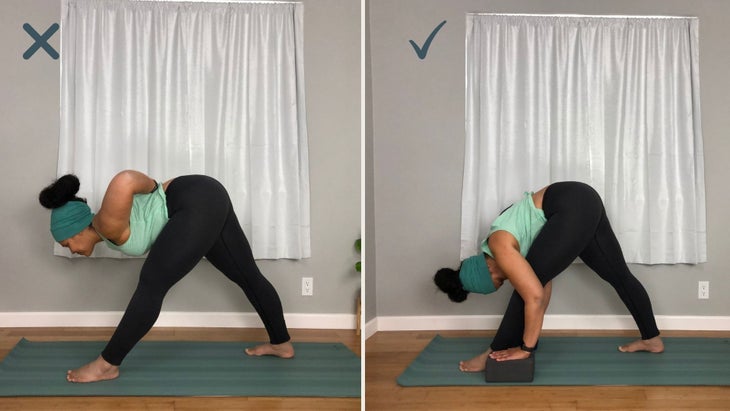
3. Instead of Paschima Namaskar (Reverse Prayer Pose) in Parsvottanasana (Pyramid Pose)
Heart-protecting variation: Place two hands on blocks and stay folded.
Why: The classic Pyramid Pose, with hands in reverse prayer, is similar to Humble Warrior in that it can teach us how to keep our hearts open when forces are trying to close it down. But, during periods where we want to stay closed, it can be comforting to stick to just the forward bend portion of the pose. Not only does this give you an opportunity to regain some strength, but it can feel quite comforting to fold in upon yourself.
How to: From the top of your mat, step one foot back a few feet. Keep both feet hip-width apart and angle your back foot forward for stability. When the rest of the class lifts their torso up and sets their arms up for reverse prayer hands and the subsequent slight backbend, grab two blocks and place them under your shoulders and bring your hands to blocks. You may opt to reach your arms forward for some length in the spine or toward the back of the mat to help you fold deeper.
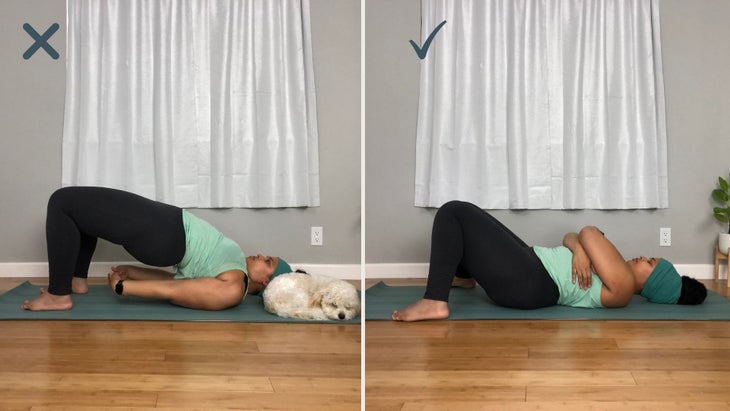
4. Instead of Setu Bandha Sarvangasana (Bridge Pose)
Heart-protecting variation: Constructive Rest
Why: This alternate variation can be an easy choice, because the setup is so similar to the requested pose. When the alternate posture echoes the requested one, then you may not feel as though you’re sticking out from the crowd, which can be a common concern among some students when doing your own variation.
How to: Lie down on your back and bend your knees. Separate your feet as wide as your mat or wider, and let your knees rest against each other. As the rest of the class lifts their hips and interlaces their fingers behind their backs, keep your pelvis on the floor and cross your arms in front of your body. Wrap your right arm over your left, giving yourself a tight hug. Let your elbows hang heavily toward your belly button. There should be a sense of ease. Remain for as long as the class is lifted in Bridge. Switch arms when they do their second round.
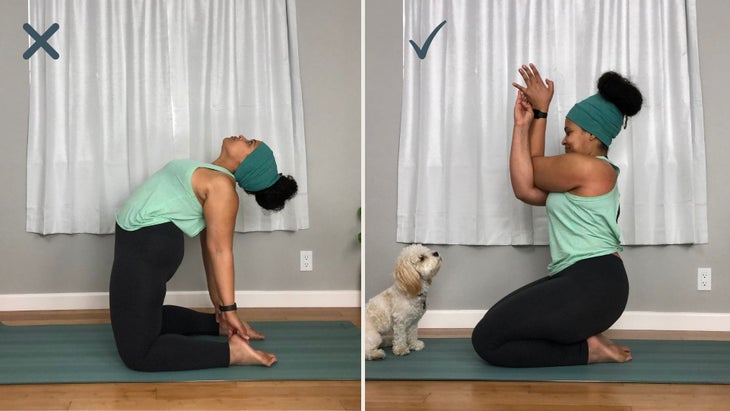
5. Instead of Ustrasana (Camel Pose)
Heart-protecting variation: Vajrasasana (Thunderbolt Pose) with Garudasana (Eagle Pose) arms
Why: There are a lot of ways to modify Camel Pose using props to lessen the intensity, but when going through a period of heartache or grief, even the slightest chest-opener can feel like knives going into your back. Remaining on your heels and giving yourself a hug with Eagle arms is not only comforting, but it gently invites a little upper back opening, which can be helpful for our breath.
How to: Come onto your knees. Bring your knees and ankles together and sit onto your shins. When the rest of the class lifts their hips into Camel Pose, you will stay seated. Rather than following the cue to reach your arms back, reach your arms forward and cross your right elbow over your left coming into Eagle Pose. Wrap your forearms and press your palms if you’re able. If full Eagle feels like too much today, repeat the hug variation from the Constructive rest option. Switch sides on their second round.
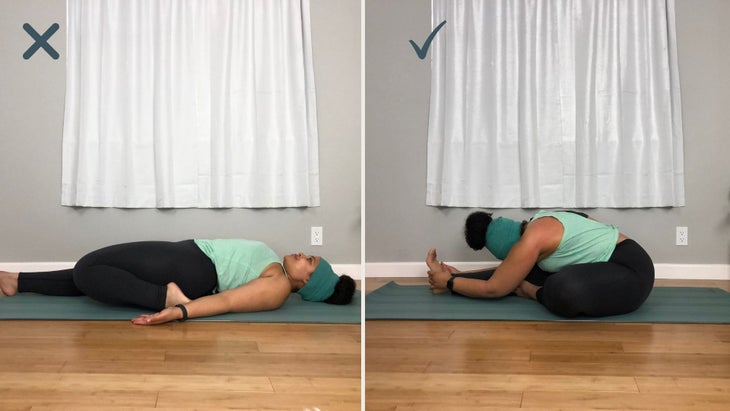
6. Instead of Supta Eka Pada Virasana (Reclining One-Legged Hero’s Pose)
Heart-protecting variation: Janu Sirsasana (Head-to-Knee Pose)
Why: Some backbends are taught within the seated portion of class. If you are in a heart-closing period, it can feel frustrating that just when you think it’s finally time to fold forward, the teacher sequences one more chest and front-body opener. Please remember that you should always choose which direction to go based on your body’s needs that day.
How to: Come to sit in Paschimottanasana (Seated Forward Bend) with both legs straight ahead. Rather than taking your right leg back into Supta Virasana (Reclining Hero Pose), you will bend your right knee and pull your right heel up toward your left groin. When the rest of the class remains upright or leans back, you will fold forward over your left leg. You may grab your left foot or simply rest your fingertips, palms or elbows on the floor, and fold.
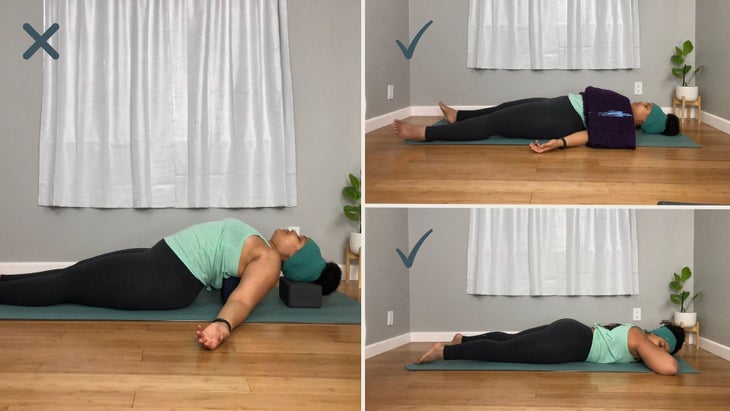
7. Instead of: Supported Matsyasana (Fish Pose) on blocks
Heart-protecting variation: Savasana (Corpse Pose) with a blanket over your chest OR Savasana on your belly.
Why: Perhaps the sneakiest of heart-openers is when a teacher suggests we make our Savasana (Corpse Pose) into a chest-opener by taking supported Matsyasana in its place. Savasana is already a vulnerable pose for many. Luckily, there are a couple of options to keep yourself feeling protected and safe, so you can rest fully, which is something you desperately need during challenging times. The first option is to place something weighted across your chest, like a blanket or two. Or you can always opt to do the pose entirely on your tummy.
How to: Option 1: When the rest of the class grabs blocks to lie upon, you will grab a blanket and lie directly onto the floor. Take your blanket across your chest at shoulder height. It should feel weighty. If it’s too light, consider a second or even third blanket. If it feels safe, close your eyes or cover them with a towel or eye pillow.
Option 2: Roll onto your tummy and take Savasana on your belly. You can make a pillow with the back of your hands to rest your forehead keeping your neck long, or you may alternate turning your head from side to side.

